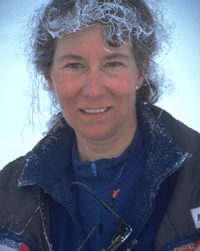Matty McNair has made a career out of breaking records and setting a new standard for female adventurers.
Matty McNair never intended to set world records, lead all-women expeditions or kite-ski at the South Pole with her two children. She simply wanted to keep up with her dad. From a young age she was told she wasn’t strong enough, wasn’t tall enough and life in the outdoors just wasn’t for her, but she has always been determined to prove otherwise.
She was just 2 when she started skiing. Thirteen years later she had already qualified for the national whitewater slalom championships, biked with her family across Europe and competed in cross-country ski races throughout Colorado. After another decade, she had gone rock climbing in Peru and Bolivia. Ten years after that, she moved her family to the Canadian Arctic. For 40-plus years she has been breaking world records and refuting common misconceptions about what women shouldn’t do.
After finishing school, she became one of the first female guides for Outward Bound, where she worked for 22 years. With few female role models to turn to, she worked hard to find her own unique style of teaching, the one that would prove to be most effective. McNair quickly realized the many ways that being a woman was an asset while leading an outing. In 1990, she traveled 2,485 miles around Baffin Island—her mode of transportation: a dog sled. In 1997, she led the first all-women expedition to the North Pole. Instead of trying to ignore gender differences, McNair embraced them. While men tend to run dogs using fear and dominance, she believes that women tend to steer clear of rough handling and run them by forming a close bond with them.
“When I drive dogs,” McNair explains, “there is an energy that I can project, and that dogs can pick up on. It blows me away how often I think of something and they immediately pick up on it. They follow me anywhere, and are anxious to catch up. When men lead, [the dogs] tend to slow down more, or go off in different directions.”
She also found some differences between men and women on her first women-only trip. “The major difference between our expedition and the men's expeditions is that we took care of ourselves,” McNair explains. “We went in style. We had sponge baths and snow baths, no frostbite, no hypothermia and no exhaustion. Every other expedition has had one or all of these problems. The female side tends to be more compassionate, and automatically help each other out,” McNair says.
McNair also found that women tend to do better when working together. Because of this, she insisted that the team have only one tent. “It’s easy to stop the whining if all of us are face to face. If any of us had issues, we just had to let it go.” For 74 days, she led the Women’s Polar Relay Expedition. The journey took 20 ordinary British women and one assistant guide from the Ward Hunt Island in the Canadian Arctic to the North Pole. “It wasn’t like a rock climb, or something short and sweet. There was lots of mental strength needed. Things hurt, day after day. It wasn’t all physical. The most difficult part is the mental challenge. And I actually found that the older women were some of the strongest.”
In 2003, she crossed the Greenland Ice Cap with her children, Sarah and Eric, by ski-kite and dog sled. A year later, she would return again with her two children, but leave the dogs behind. With just three sets of skis and three kites, they traveled unsupported to the South Pole, again setting world records and transcending both age and gender barriers. The McNair clan traveled over 745 miles to the South Pole in just 52 days, and made the return trip in 17. Her children, obviously taking after their mother, became the youngest in the world to ski to the South Pole at just 18 and 20 years old.
As the owner and expedition leader for North Winds Expeditions, McNair has a self-professed addiction to adventure. From kayaking and canoeing to dog sledding and kite-skiing, she has never taken no as an answer, but more as a challenge.
